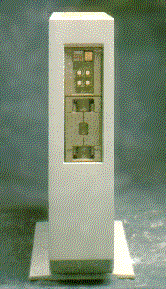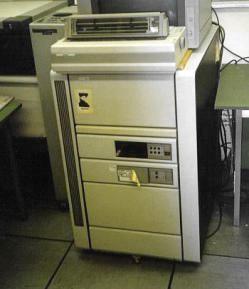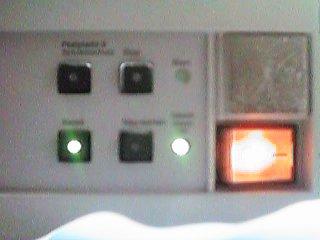



The BA23 is one of the most widely used Digital small system enclosures. it was first used with the MicroPDP-11/23 and other qbus PDP-11 systems, and then with the MicroVAX/VAXstation I and MicroVAX/VAXstation II. It's sleek, it's stable - but you might have to take care when you work with it.
When we say "BA23", we mean the system enclosure, which includes the qbus backplane/cardcage, the power supply unit, two mounting bays for full-height, 5.24" storage devices (HDs, tapes, floppy drives), a backpanel for cutouts, a distribution- and a front-panel for the storage devices and system power control. This is just a golden box, which can be mounted in various ways:

The "average" BA23 frontpanel has 4 pushbuttons, 2 separate LEDs and a big powerswitch. The switches are: Halt, Restart, HD ready, HD write protect. The LEDs: DC OK, Run. The other sort of frontpanels has two more pushbuttons for HD ready/HD write prot. on the second drive inserted. The HD Ready button is an indicator: it lights up when the drive is ready (were talking about RD/RX drives on an RQDX1/2/3 controller, attached to the drive distribution/cable patch panel on the back wall of the drive bays, which is attached to the frontpanel too), in the out position. If you press it, the drive goes offline. The use of the Write protection button is more trivial: the drive's protected when it's pushed in, and writable when in the out position. The Restart button restarts the system, it's not a wise thing to push it when the system's running. The Halt button brings the system to the halt state when pushed in, and release it when pushed again.
There's a patch panel on the back side of the two device bays for distributing signals for hard disk and floppy drives. This can be used with the RQDX1/2/3 controller: a wide ribbon cable from the controller board is attached to this panel, and the cables going to the drives start here. The default is one hard disk drive per BA23/RQDX, if you want to use two, you have to use the six-button frontpanel or tinker around with the cables.
The qbus backplane can be accessed from the back side, after unscrewing two screws and removing the back mounting panel. The top of the box above the device bay and the backplane can be removed (having a few screwdrives around is essential - the BA23 was built to be quite rigid and stable, it's not a desktop box that can be dissassembled without instruments).
BA23s operate very smoothly when used properly (cleaned, proper circulation of air is possible on the side with the fans and on the opposite!). Early revisions (in MicroPDP-11/23 and MicroPDP-11/53 systems) had a problem with the power cables which could led to fire, but this should have been fixed with most of the BA23s. They can run for years without problems, but configuring it can be a pain. First: the cables that connect the devices in the device bays with their controller are going under the backplane and the RQDX patch panel. There is a small "tunnel" for them , but it's very slim: sometimes you must remove the boards and backplane to lead some cables through there. Second: the cardcage is rather small, you have to isnert cards one after another. Taking out a module from between two others can damage some/all of the boards involved. And an advice: don't use the BA23 opened, without the covering parts for a long time (testing, e.g. to observe some diagnostics LEDs is okay): the air circulation is best with the enclosure closed!
Dimensions: ~15.2 cm x 64.2 cm x 72.6 cm
Weight: ~62 kg
Maximum power consuption: 345W
Acoustic emission (LPA): 48 dB
Operating temperature: 10-40 deg. Centigrate (Celsius); 50-104 Fahrenheit
Operating humidity: 20-80% (non-condensing)
Back to the top
Back to the qbus page
Back to the main page
| Created by: Ákos Varga | Last modified: |